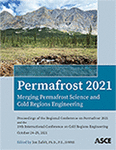Regional Conference on Permafrost 2021 and the 19th International Conference on Cold Regions Engineering
Embankment Fill Slope Movement on Thaw Sensitive Permafrost: Combining Creep Testing and Thermal Simulations to Develop Mitigation Options at Lost Creek along the Trans-Alaska Pipeline System; Lost Creek—Part 2
Publication: Permafrost 2021: Merging Permafrost Science and Cold Regions Engineering
ABSTRACT
The Trans-Alaska Pipeline System was constructed in the 1970s to transport warm oil through a 48-inch-diameter pipeline (mainline) 800 miles from Prudhoe Bay to Valdez, Alaska. The system traverses continuous and discontinuous permafrost terrain and is supported aboveground or buried, depending on subsurface conditions. The Lost Creek site is a northwest-facing cut and fill slope in discontinuous, warm permafrost. The mainline is supported aboveground by vertical support members (VSMs). Since 1990, Alyeska Pipeline Service Company has observed signs of ground and VSM movement. Movement mechanisms at the site include longitudinal creep movement along a shear zone in ice-rich permafrost and transverse shoulder rotation due to thaw settlement. The movement causes lateral pile loading, VSM displacement, and embankment shoulder failure. This paper presents the methods we used to develop options to mitigate slope movement at the site. We present our interpretation of site conditions in a separate paper within these proceedings.
Get full access to this article
View all available purchase options and get full access to this chapter.
ACKNOWLEDGEMENTS
The authors would like to thank Dr. John Zarling of Zarling Aero and Engineering for his input and guidance on our thermal simulations and Dr. Margaret Darrow and Dr. Matthew Bray of UAF for providing creep test results for our modeling and this paper and for their assistance interpreting the transient creep test results.
REFERENCES
Andersland O. B., and Ladanyi, B., 2004, Frozen Ground Engineering, 2nd edition, John Wiley & Sons, 363 p.
Bray, M. T., 2013, Secondary creep approximations of ice-rich soil and ice using transient relaxation tests: Cold Regions Science and Technology, v. 88, 17-36.
Cermak, V. and Rybach, L., 1982, Thermal properties: thermal conductivity and specific heat of minerals and rocks, in Angeneister, G., ed., Landolt-Bornstein Zahlenwerte und Funktionen aus Naturwissenschften und Technik, Neue Serie, Physikalische Eigenschaften der Gesteine: Berlin, Springer Verlag, v. 1a, p. 305-343.
Darrow, M. M., and Bray, M. T., 2018, Lost Creek (PLMP 392) creep analysis, final report: Report prepared by Institute of Northern Engineering, Fairbanks, Alaska, for Alyeska Pipeline Service Company, 69 p., April.
Geo-Slope International, 2018, TEMP/W v 9: Calgary, Alberta, Geo-Slope International.
Johansen, O., 1975, Thermal conductivity of soils, Ph.D. diss., Norwegian Technical Univ., Trondheim; also, U.S. Army Cold Regions Research Engineering Library Transl. 637, July 1977.
Jorgenson, T.; Yoshikawa, K.; Kanevskiy, M.; and Shur, Y., 2008, Permafrost characteristics of Alaska: University of Alaska Fairbanks, Institute of Northern Engineering, Fairbanks, Alaska.
Lunardini, V.J., 1981, Heat Transfer in Cold Climates: Hanover, N.H., U.S. Army Cold Regions Research and Engineering Laboratory, 731 p.
McRoberts, E. C.; Nixon, J. F.; Hanna, A. J.; and Pick, A. R., 1985, Geothermal considerations for wood chips used as permafrost slope insulation, in Kinoshita, Seiichi and Fukusa, Masami, eds., Fourth International Symposium on Ground Freezing, Sapporo-shi, Japan, 1985, Proceedings: Rotterdam, A. A. Balkema, p. 305-312.
National Oceanic and Atmospheric Administration (NOAA), 2018, Climate data, daily summaries, for Gulkana Airport, AK US station: Available: https://www.ncdc.noaa.gov/cdo-web/datasets/GHCND/stations/GHCND:USW00026425/detail, accessed October 2018.
Scenarios Network for Alaska Planning (SNAP), 2018, Derivation of SNAP climate projections. University of Alaska–Fairbanks. Available from https://www.snap.uaf.edu/, accessed October 2018.
Wagner, A. M., 2014, Review of thermosyphon applications: Washington, D.C., U.S. Army Corps of Engineers Cold Regions Research and Engineering Laboratory, Report no. ERDC/CRREL TR-14-1, 46 p.
Information & Authors
Information
Published In
Permafrost 2021: Merging Permafrost Science and Cold Regions Engineering
Pages: 360 - 373
Editor: Jon Zufelt, Ph.D., HDR Alaska
ISBN (Online): 978-0-7844-8358-9
Copyright
© 2021 American Society of Civil Engineers.
History
Published online: Oct 21, 2021
Published in print: Oct 21, 2021
Authors
Metrics & Citations
Metrics
Citations
Download citation
If you have the appropriate software installed, you can download article citation data to the citation manager of your choice. Simply select your manager software from the list below and click Download.
